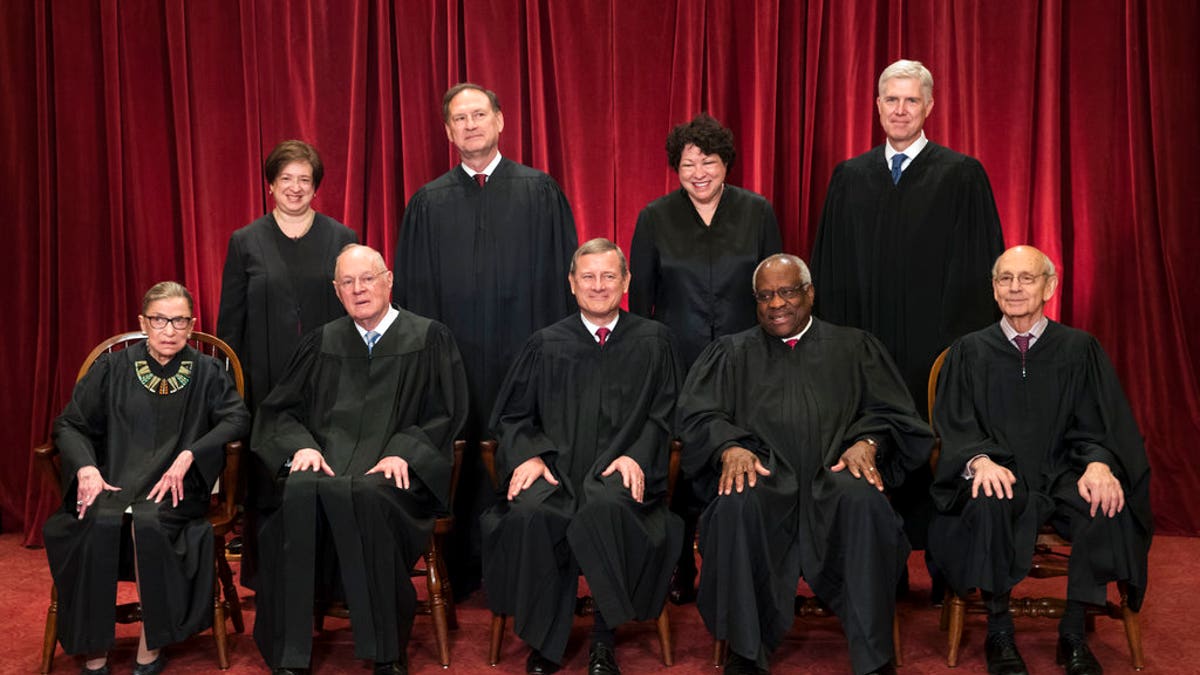
The justices of the U.S. Supreme Court gather for an official group portrait on June 1, 2017, to include new Associate Justice Neil Gorsuch, top row, far right at the Supreme Court Building in Washington. Seated, from left are, Associate Justice Ruth Bader Ginsburg, Associate Justice Anthony M. Kennedy, Chief Justice John Roberts, Associate Justice Clarence Thomas, and Associate Justice Stephen Breyer. Standing, from left are, Associate Justice Elena Kagan, Associate Justice Samuel Alito Jr., Associate Justice Sonia Sotomayor, and Associate Justice Neil Gorsuch. (AP Photo/J. Scott Applewhite, File)
With President Trump planning to replace retiring Justice Anthony Kennedy, many on the left fear a Supreme Court that will regularly rule against them, even reversing landmark decisions like the one rendered in “Roe v. Wade.”
Thus, they’re using whatever means are available to prevent this.
One of the more extreme plans is court packing — that is, creating more positions on the Supreme Court to change its political balance. The idea has been suggested by, among others, the liberal New Republic magazine, Harvard Law fellow Ian Samuel and David Faris, associate professor of political science at Roosevelt University and author of “It’s Time To Fight Dirty.”
Packing the Supreme Court, legally speaking, isn’t that tricky. As Fox News legal analyst Judge Andrew Napolitano notes, while the Constitution creates a Supreme Court, “it is silent on the number of justices.” Therefore, changing the number of judges who sit on the high court “would be just like any other legislation: It would require a majority in both houses of Congress and the president’s signature, or enough votes to override the president’s veto.”

Supreme Court Justice Anthony Kennedy. President Trump is moving swiftly to present a nominee for the opening on the bench. (AP, File)
But, politically, it wouldn’t be easy. In the first 80 years of the Supreme Court’s existence, Congress played around with the number of justices quite a bit — often to help or hinder the president in getting the court he wanted. Thus the court first had six members, then five, then seven, then nine, then 10, then eight, finally settling on nine with the Judiciary Act of 1869. It has been nine ever since.
In the 1930s, however, President Franklin Roosevelt had a plan. Known as the Judicial Procedures Reform Bill of 1937, it would have allowed for the president to appoint up to six more justices to the Supreme Court.
As Judge Napolitano explains, “the true reason was the persistent rejection on constitutional grounds of New Deal legislation” — that is, FDR was unhappy with the Supreme Court’s rulings, so wanted to appoint his own justices to change that.
In general, the public opposed the bill, and it died without getting a vote in Congress. Around the same time, however, Justice Owen Roberts switched his position in favor of New Deal legislation; some believed he was trying to stave off FDR’s plans for the court. Roberts' change became known as “the switch in time that saved nine.”

Franklin D. Roosevelt, 32nd president, contemplated some significant tinkering with the composition of the high court. (AP, File)
Ever since FDR’s plan failed, however, the very idea of court packing has been considered radical. But at present, it seems some on the left want to be radical. The trouble is, at the very least they’d need the Democrats to take back the House, the Senate and the presidency. And once that happens, they’d need to convince the party to take what would likely be a highly unpopular step with the general public.
The other problem is, two can play at that game. After all, right now it’s the Republicans who hold Congress and the White House. Not that court packing would be any more popular if they tried it than if the Democrats made the attempt. As Napolitano notes, “if the Republican Congress wanted to give Trump 10 more appointees, they could increase the court to 19, [but] I would think there’d be a comparable outcry to when FDR attempted to do this.”
Further, he notes, with court packing "you’re going to end up with a Supreme Court that looks like a legislature at some point -- [both sides will] keep expanding it in order to overturn what the previous court has done.”
So what should those on the left do? Well, try to win more elections, of course. But also, perhaps they — as well as those on the right who support court packing for their side — could take the longer view. As Napolitano explains, the Supreme Court “is a pendulum that swings back and forth. In the Eisenhower and JFK and LBJ years, we had the [more progressive] Warren Court. It’s just the nature of the system — power shifts.”
He also notes no one knows what will come up in the future, and “just because there are conservatives on the court, there’s no guarantee how things are going to turn out.”
Napolitano says he understands there are “progressives impatient to reverse what happened in the Trump years,” but believes “thoughtful people who understand history” would never support changing our system this way.
But those who back court packing believe Americans are in danger of losing fundamental rights, so they see extreme action as necessary. As The New Republic puts it, “Desperate times call for desperate measures.”
So will this idea gain any traction? Perhaps it depends on how desperate people get.
























